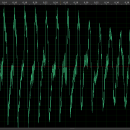
Es que sí que parece ser un compresor, programado especialmente para transitorios.
Transmodder is a transient-driven filtering system. It can be also called a transient modification system since it allows the user to modify the audio material by means of dynamic filtering--in accordance with the transient content of the signal--delivering a spectacular sonic pronunciation and definition.
The core element of Transmodder is transient analyzer which processes narrow- or broad-band signal and detects all rising-level transients such as snare drum, bass drum, high hat hits, vocal syllables and other types of transients. In the course of detection transient analyzer generates envelope signal which replicates transient structure of the signal being analyzed. This also includes detection of differences between sharp and soft transients which generate high and low envelope levels, respectively.
Transmodder features five dynamic filters. Each can be controlled by envelope signals generated by up to two transient analyzers. The good thing about the filters used in Transmodder is that they work in a bypass mode when the envelope stays at zero causing no coloration to take place. This is especially useful in mastering applications where processing transparency is usually desirable.
The most evident purpose of this plug-in is to make the bass and high frequency content stand out in the mix or make it less noticeable. This effect is very different from what a compressor/expander does because Transmodder 'sees' transients only. So, if there is a cymbal sound, only its very beginning will be 'seen' by Transmodder: cymbal sound's body will be left unchanged. Moreover, transient detection does not depend on the absolute incoming sound level. That is why in Transmodder there is no such parameter as 'processing threshold'.
Transmodder is a useful mastering-stage plug-in. Since it is not extremely CPU consumptive it can be used in track insert slots, too. Transmodder can work extremely good with drums, guitars and bass. One of the most remarkable thing in this 'transient' processing is that in most cases it adds punch and brightness without severely affecting the overall perceived frequency balance.
Four transient analyzers
Five dynamic filters
Real-time spectrum analyzer
Transient detection meters
Mid/side channel processing
Factory presets
"A-to-B" comparisons
Mono-to-Stereo, Stereo-to-Stereo processing
All sample rates supported
64-bit internal precision
Native assembler DSP code







